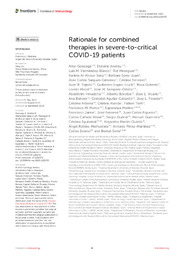Por favor, use este identificador para citar o enlazar este ítem:
https://hdl.handle.net/11000/34837Registro completo de metadatos
| Campo DC | Valor | Lengua/Idioma |
|---|---|---|
| dc.contributor.author | Gonzaga, Aitor | - |
| dc.contributor.author | Andreu, Etelvina | - |
| dc.contributor.author | Hernandez Blasco, Luis M. | - |
| dc.contributor.author | Meseguer, Rut | - |
| dc.contributor.author | Al-Akioui-Sanz, Karima | - |
| dc.contributor.author | Soria-Juan, Bárbara | - |
| dc.contributor.author | Sanjuan-Gimenez, Jose Carlos | - |
| dc.contributor.author | Ferreras, Cristina | - |
| dc.contributor.author | Tejedo, Juan R. | - |
| dc.contributor.author | López-Lluch, Guillermo | - |
| dc.contributor.author | Goterris, Rosa | - |
| dc.contributor.author | Maciá, Loreto | - |
| dc.contributor.author | Sempere-Ortells, Jose M | - |
| dc.contributor.author | Hmadcha, Abdelkrim | - |
| dc.contributor.author | Borobia, Alberto | - |
| dc.contributor.other | Departamentos de la UMH::Física Aplicada | es_ES |
| dc.contributor.other | Departamentos de la UMH::Medicina Clínica | es_ES |
| dc.date.accessioned | 2025-01-17T10:13:12Z | - |
| dc.date.available | 2025-01-17T10:13:12Z | - |
| dc.date.created | 2023-09-11 | - |
| dc.identifier.citation | Front Immunol. 2023 Sep 11:14:1232472. | es_ES |
| dc.identifier.issn | 1664-3224 | - |
| dc.identifier.uri | https://hdl.handle.net/11000/34837 | - |
| dc.description.abstract | An unprecedented global social and economic impact as well as a significant number of fatalities have been brought on by the coronavirus disease 2019 (COVID-19), produced by the severe acute respiratory syndrome coronavirus 2 (SARS-CoV-2). Acute SARS-CoV-2 infection can, in certain situations, cause immunological abnormalities, leading to an anomalous innate and adaptive immune response. While most patients only experience mild symptoms and recover without the need for mechanical ventilation, a substantial percentage of those who are affected develop severe respiratory illness, which can be fatal. The absence of effective therapies when disease progresses to a very severe condition coupled with the incomplete understanding of COVID-19’s pathogenesis triggers the need to develop innovative therapeutic approaches for patients at high risk of mortality. As a result, we investigate the potential contribution of promising combinatorial cell therapy to prevent death in critical patients. | es_ES |
| dc.format | application/pdf | es_ES |
| dc.format.extent | 18 | es_ES |
| dc.language.iso | eng | es_ES |
| dc.publisher | Frontiers Research Foundation | es_ES |
| dc.rights | info:eu-repo/semantics/openAccess | es_ES |
| dc.rights | Attribution-NonCommercial-NoDerivatives 4.0 Internacional | * |
| dc.rights.uri | http://creativecommons.org/licenses/by-nc-nd/4.0/ | * |
| dc.subject | COVID-19 | es_ES |
| dc.subject | cytokine storm | es_ES |
| dc.subject | immunomodulation | es_ES |
| dc.subject | mesenchymal stromal cells | es_ES |
| dc.subject | SARSCoV- 2 | es_ES |
| dc.subject | advanced therapies | es_ES |
| dc.title | Rationale for combined therapies in severe-to-critical COVID-19 patients | es_ES |
| dc.type | info:eu-repo/semantics/article | es_ES |
| dc.contributor.institute | Institutos de la UMH::Instituto de Bioingeniería | es_ES |
| dc.relation.publisherversion | 10.3389/fimmu.2023.1232472 | es_ES |

Ver/Abrir:
Rationale for combined therapies in severe-to-critical COVID-19 patients.pdf
2,19 MB
Adobe PDF
Compartir:
 La licencia se describe como: Atribución-NonComercial-NoDerivada 4.0 Internacional.
La licencia se describe como: Atribución-NonComercial-NoDerivada 4.0 Internacional.
.png)